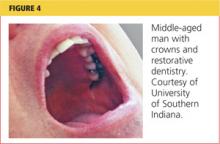1. Kaiser Commission. Medicaid and the uninsured: oral health in the US: key facts (2012). www.kff.org/uninsured/upload/8324.pdf. Accessed February 11, 2013.Healthy People 2020. Oral health. www.healthypeople.gov/2020/topicsobjectives2020/overview.aspx?topicid=32. Accessed February 11, 2013.Caries Res. 2010;44(4):390-401.J Dent. 2010;38(2):166-171.Evid Based Dent. 2011;12(2):41-42.J Am Dent Assoc. 2006;137(8):1151-1159.Clin Oral Investig. 2011;15(4):443-449.Fam Med. 2007;39(2):88-90.Health Aff (Millwood). 2010;29(7):1356-1363.Acad Pediatr. 2009;9(6):415-419.Acad Pediatr. 2009;9(6):440-445.Oral Health in America: A Report of the Surgeon General (Executive Summary; 2011). www.nidcr.nih.gov/datastatistics/surgeongeneral/report/executivesummary.htm. Accessed February 5, 2013.J Health Care Poor Underserved. 2012;23(2):570-588.Am J Public Health. 2011;101(10):1817.BMC Health Serv Res. 2010;10:336-343.Acad Pediatr. 2009;9(6):446-451.Matern Child Health J. 2010;14(1):58-66.J Dent Hyg. 2012;86(2):63-70.Sturdevant’s Art and Science of Operative Dentistry. 6th ed. St. Louis: Elsevier-Mosby; 2012:41-89.J Health Care Poor Underserved. 2011;22(3):740-744.BMC Oral Health. 2011;11:9.J Am Dent Assoc. 2008;139(3):257-268.Int J Dent Hyg. 2010;8(3):198-203.J Dent Hyg. 2011;85(3):211-219.BMC Oral Health. 2012;12:8.J Community Health. 2010;35(2):190-197.N Engl J Med. 2006;355(18):1885-1894.Am Fam Physician. 2008;77(8):1139-1144.Best Pract Res Clin Obstet Gynaecol. 2007;21(3):451-466.J Womens Health (Larchmt). 2005;14(10):880-882.J Calif Dent Assoc. 2003;31(2):135-138.BMC Oral Health. 2010;10:23.J Indian Soc Pedod Prev Dent. 2011;29(1):39-45.BMC Oral Health. 2012;12:3.Caries Res. 2009;43(5):391-396.Biol Trace Elem Res. 2010;137(2):159-167.J Health Care Poor Underserved. 2011;22(3):1048-1058.J Indian Soc Periodontol. 2010;14(4):207-212.BMC Nephrol. 2012;13:16.J Cancer Res Ther. 2012;8 suppl 1:S57-S66.Am J Public Health. 2007;97(12):2216-2221.Am J Public Health. 2011;101(10):1882-1891.Am J Public Health. 2010;100(11):2262-2269.

